Ethiopian cuisine is one of my absolute favorites. I love everything about it. The wonderful flavors, the fact that it is a sharing meal so I can try many different dishes. I even love eating with teff injera instead of a fork!
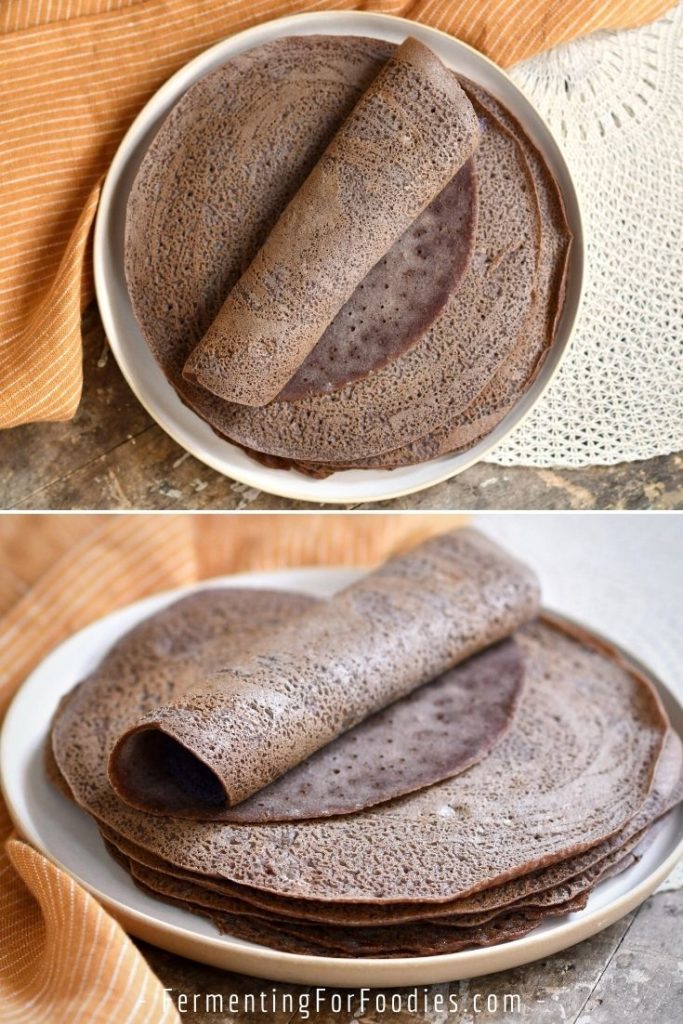
Eating with your fingers is always fun!
There is only one thing that makes going out for Ethiopian food difficult… the fact that I can’t find anywhere that makes injera without wheat. What is a gluten-free foodie to do?
The answer, of course, is to learn to cook Ethiopian food at home!
What is teff injera?
Teff injera is an important part of Ethiopian cuisine.
- Injera is a spongy sourdough pancake, traditionally made from teff.
- Teff is a gluten-free seed with a rich, nutty flavor. It has a natural, symbiotic relationship with yeast. So it sourdough ferments very quickly. Seriously, it only takes 6 to 24 hours for a bubbly ferment. (See photo below).
- In restaurants, injera is served as a giant pancake topped with various stew-like dishes. Small pieces of injera are used to pick up the stews and eat.
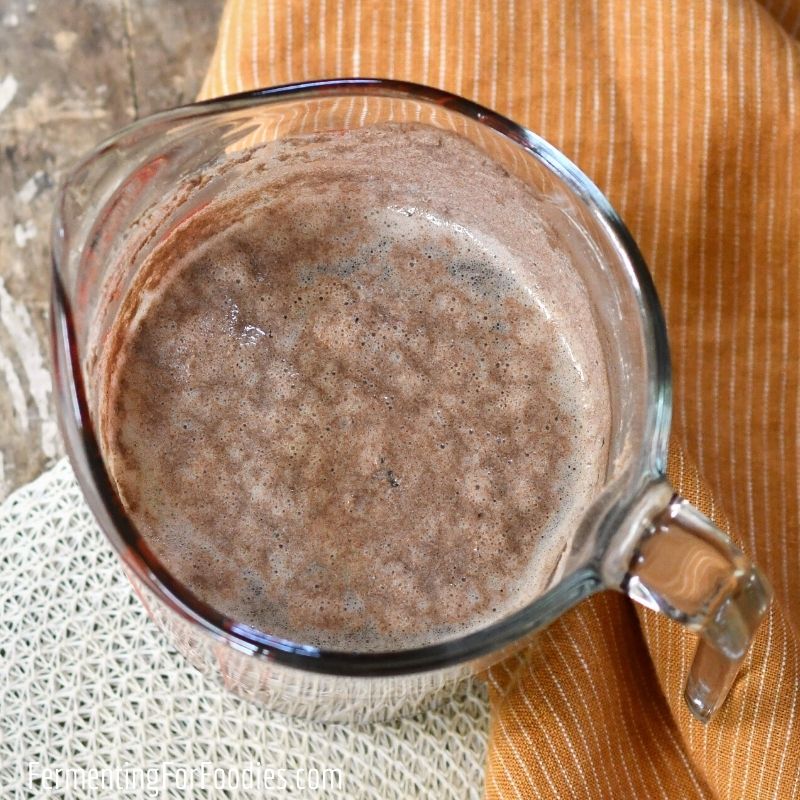
Dishes to serve with injera
Here are some of my favorite dishes to serve with injera. Some of these are traditional Ethiopian dishes, while others are not.
- Misir Wat: a spiced red lentil stew.
- Shiro Wat: a simple stew made from chickpea flour and spices (in the photo below).
- Fasolia: a green beans and carrots dish.
- Goman Wot: a spinach stew.
- Simple Spiced Cabbage and Potatoes: a vegetable stew made with cabbage, carrots, and potatoes (in the photo below).
- Turmeric Spiced Sauerkraut is not traditional. However, the flavors offer a nice addition to an Ethiopian meal.
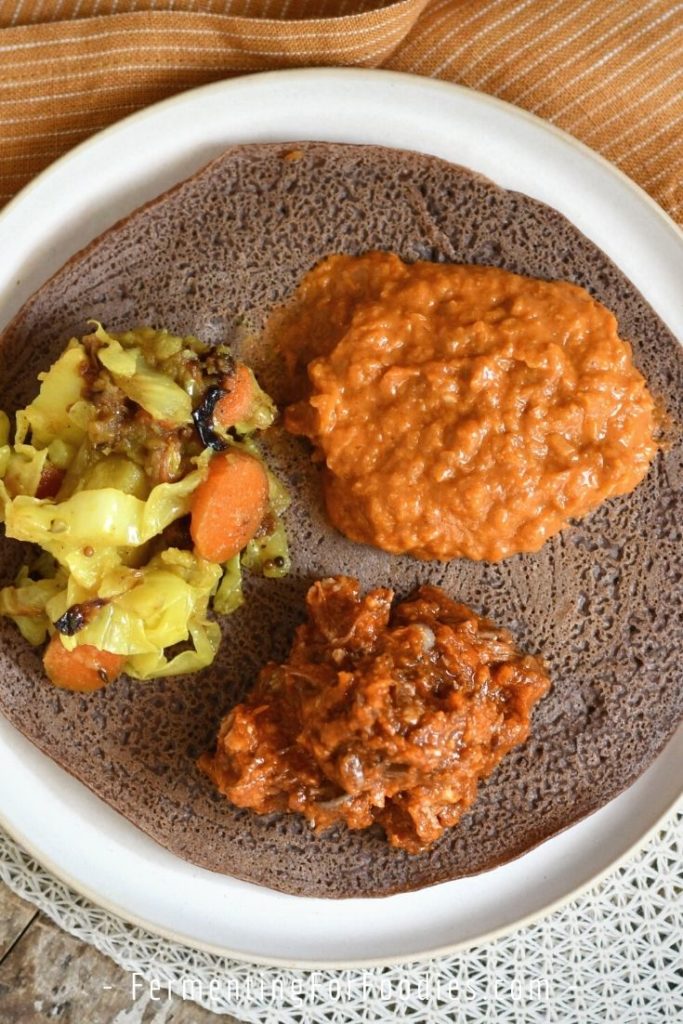
Teff Injera -Ethiopian Flatbread
Teff injera is a naturally fermented flatbread. Injera has a deliciously nutty and sourdough flavor that compliments traditional Ethiopian stews. See the section above for links to a few traditional Ethiopian stew recipes.
- Prep Time: 10 minutes
- Cook Time: 15 minutes
- Total Time: 25 minutes
- Yield: Serves 4-6 1x
- Category: Bread
- Method: Sourdough
- Cuisine: Ethiopian
- Diet: Gluten Free
Ingredients
Preferment
- 1 1/2 cups of teff flour
- 1 3/4 cups water
Remaining Ingredients
- 1/2 tsp salt
- 1 egg (optional, see notes)
- Vegetable oil (for frying)
Instructions
- Mix the teff and water in a glass bowl or measuring cup. Leave it somewhere warm to ferment for 6-24 hours. It should develop into a nice bubbly starter pretty quickly. Stir once or twice during the ferment.
- When you are ready to cook the injera, beat in one egg and add salt, to taste.
- Heat a non-stick skillet on medium heat and brush on some oil.
- Put in a small amount of batter into the center of the skillet, then turn the skillet around so that it forms a thin pancake (though not as thin as a crepe).
- Cook slowly on one side until the injera is set. Injera is traditionally cooked only on one side. It is supposed to be quite wet and soft on the other side. However, if you want to cook both sides, make smaller pancakes and flip them.
- Serve injera right away, or allow them to cool before stacking to keep them from sticking.
Notes
- Look for teff flour in African grocery stores, in the gluten-free area of a health food store, or online
.
- Traditional recipes don’t use an egg. However, it is difficult to prevent injera from sticking to the pan and falling apart without some sort of binder. Most restaurants replace up to 1/2 the teff in their injera with wheat flour, which provides the necessary structure. I added an egg for a 100% teff recipe. If you want to make it egg-free, then no replacement for the egg is necessary. Either make small pancakes or replace 1/2 of the teff with wheat flour.
- To make really large injera you need to invest in an injera pan
. Otherwise, just make smaller injera in a frying pan.
- See the section above for links to my favorite Ethiopian stews.
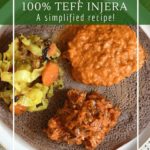
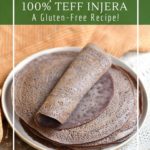
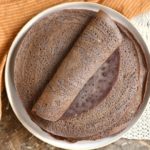
We’ve made this and your stews a few times now, worked great everytime. I love it! I’ve made my own berbere mix for the stews and toned down the spice so the kids didn’t get spooked.
Perfect! Glad you found a spice level that works for you.
My batter didn’t bubble 🙁 I left it for 24 hours. Any idea why? In other recipes people add active yeast?
I definitely wouldn’t add bread yeast, which would be way too active. Try making injera with your 24 hours soaked teff and see how sour it tastes. You may find that it has the right flavour. 🙂
There are a few reasons why you might have struggled to get a bubbly starter. This is a wild yeast ferment and really depends on your indoor air quality. If you’re new to fermenting it can take a while to build up the wild yeast in your air. It’s harder to do that if you have HEPA filtered air or if you live somewhere with poor air quality. Regardless, if you enjoy the injera, you should definitely try again. Every batch will slowly build up the quality of wild yeasts in your home. Good luck!
Fermentation will not work well if you are using chlorinated (tap) water. You can use tap water if you let it sit overnight to evaporate off the chlorine, or speed up the process by boiling the tap water for 5 minutes, then letting it cool down to room temperature before mixing it with the teff.
True! Thanks for sharing.
I use this all the time now, so easy to follow and these flatbread are so versatile! (I love using then as soft taco shells too). Thanks for the recipe ^__^
I never thought of using them for taco shells. Thanks for sharing!
Hi! I was wondering if i should be covering my injera batter? I read the comment you replied to about wild yeast being in the air and while i am quite new to this recipe, i didn’t want the bugs in my house investigating if it was supposed to be uncovered. thought i would ask just in case and see if there was anything else i could do to catch the gist of the recipe faster! thank you!
I always cover my wild ferments with a tea towel or paper towel. It keeps the fruit flies out. (Also the cats out at my house)! The wild yeasts and bacteria can easily get through one layer of cloth. Teff is usually very quick at fermenting, so be sure to take a look at it within 24 hours! Cheers, Emillie
Hello. Do you suggest adding a teff sourdough starter? I have a packet.
It’s not necessary, but feel free to use it if you want. Just ferment for less time, as teff sours really quickly. Enjoy!
hi this is a large recipe for one person and teff is pricey. can the bread/batter be saved for the next day or does it have to be used within 24 hours? thanks
You can definitely cook it up over a 2-3 day period. Just store it in the fridge after you’ve mixed the egg in. Cheers!
Okay made this and it didn’t ferment. Also it was really watery,tried adding the egg and made first pancake but it totally fell apart when removing it from pan. ‘
Sorry that it didn’t work out for you! Did you use 100% teff flour? Usually, teff has a symbiotic yeast that is present in the grain which is why it naturally ferments quite quickly. Maybe you found a brand that is pasteurized rather than raw? Flipping is difficult. Perhaps try making smaller pancakes until you get the hang of it. Cheers!
This recipe sounds amazing. I’ll be replacing the egg with some wholewheat flour instead. Would I add the wheat flour after the teff and water has fermented?
I haven’t made this with wheat flour, however, I would replace part of the teff flour with wheat flour. Eg. 1/4 cup of wheat flour in place of 1/4 cup of teff, then keep the water to the same proportions. In that case, I would mix the wheat into the ferment but expect that it would build up some gluten structure. 🙂 Cheers! Emillie
Ahh that makes sense, I understand.
Thanks so much x
Just made this with 100%teff . Left for five days before adding the egg and making side plate sized pancakes. Fantastic was the general re action. Relief was mine. I did use the airing cupboard to get the ferment going and after four days it was great.Served with your recipes for Shiro Wat and Gomen Wat .
So glad you enjoyed this recipe! Teff is generally very quick at fermenting. 🙂
I’m going to try this with some
Wheat sourdough starter instead of an egg
Great idea! Many restaurants use 50/50 teff and wheat to give it structure. I’m GF, so that doesn’t work for me… but I bet your flatbread will hold together nicely. 🙂